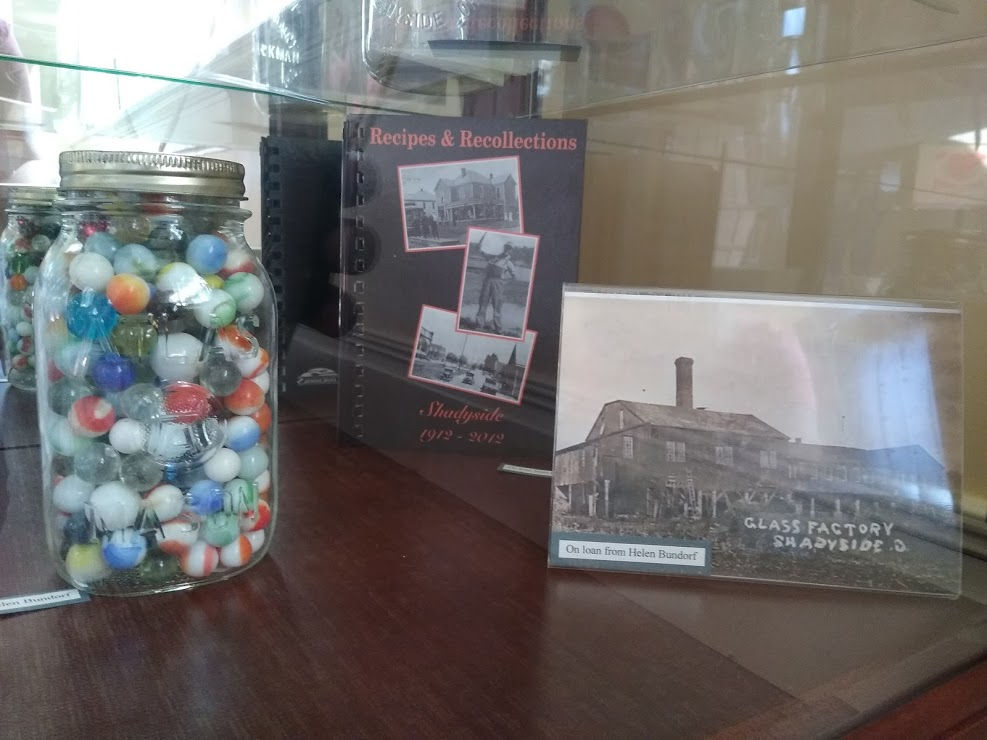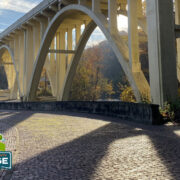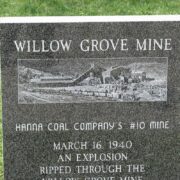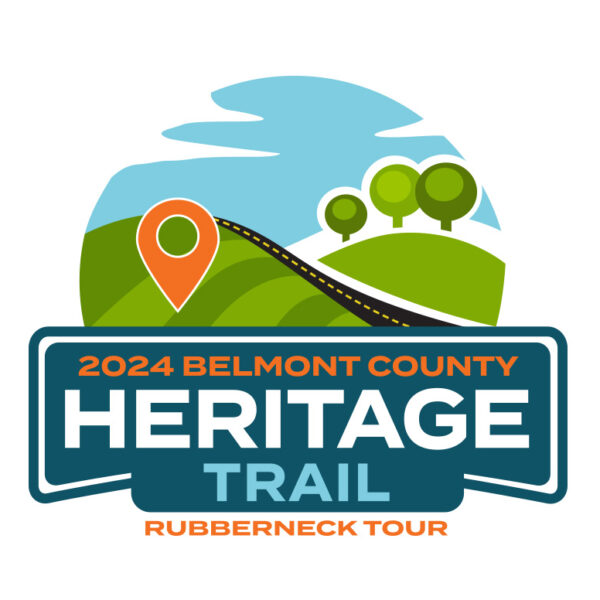
Hidden Gems at the Belmont County Heritage Museum
The Belmont County Heritage Museum (formerly the Belmont County Sheriff’s Residence Museum) is located in St. Clairsville, Ohio and houses books, pictures and artifacts representing the history of the different cities and villages in the county.
The following are pictures and short descriptions of just some of the thousands of items housed in this beautiful building that once served as the jail and residence of the county sheriff and their family.
1. Jar of marbles from the Shadyside Glass Factory – These colorful marbles were made by placing them in a giant bowl (not the official term) in the ground. They would take pieces of molten glass and drop it down the side and they would roll down forming into balls.

2. Belmont Brewery Items – This serving tray, advertisement, tap, and bottles represent items from the Belmont Brewing Co. that operated in Martins Ferry for seven years from 1933-1940.

3. Replica of USS Constitution – Josiah Fox was born in England and came to America. In the 1790s, he was hired by the government to help design ships. His most notable work was the USS Constitution. It was a frigate that could withstand cannonballs due to the way it was designed. Cannonballs literally bounced off her oak sides, earning her the nickname, “Old Ironsides”. Josiah’s work designing war ships conflicted with his Quaker faith and as a result, he was expelled from the church, but later reinstated.

4. Painting of downtown St. Clairsville street scene – This painting, on loan from the St. Clairsville Public Library, shows the Belmont County Courthouse in the background, Hudson’s restaurant, Moses’ barbershop, and the Western Auto Store. It also shows an apparently illegally parked automobile next to a fire hydrant. The automobile bears the license plate number CP-31 which belonged to Dr. C.V. Porterfield. His office was located at that spot on main street. According to family lore, Sullivan attempted to sell the painting to Dr. Porterfield but he declined. It was eventually sold to Dr. J.B. Martin who also had a medical practice in town. Dr. Martin used a medicine directions sheet glued to the back of the painting to inscribe the following directive: “At my death this picture goes to Dr. Robert A. Porterfield. April 2, 1959” Signed J.B. Martin. Upon Martin’s death the painting hung in Dr. Porterfield’s office until his death when it was transferred to his family who donated it to the library in 2005.

5. Red Spelling Board – This spelling board was used by school children to learn how to spell. It is one of many unique and interesting items in the display of the Great Western Schoolhouse. This one-room school was built in 1870 and closed in 1952. It is located on the Ohio University Eastern campus, and is open for scheduled tours to classrooms and others by appointment.
The school was built by the Clark Construction Company on property owned by Mr. Simpson Lentz, the local tavern proprietor. Bricks for the school were made from clay taken from the farm pond near the building. This “modern” school was named for a steam ship which had crossed the Atlantic Ocean in a record-setting 15 days.

6. Frizzi’s Market display – After 100 years of operation, the Frizzi Market in West Bellaire closed and is now home to Around the World Gourmet. The market was started by the Frizzi family in 1919. This new display at the Belmont County Heritage Museum includes items from the store such as grocery carts, scales, postage stamp machine, and product packaging. After immigrating to America in 1910, two young Italian brothers – Artemio and Abramo Frizzi – opened a grocery store in 1919 in Bellaire. After Artemio moved to California, Abramo and his wife, Philmena, known as “Abe” and “Minnie” to Bellaire residents, moved the store to 2783 W. Washington St. The Frizzi’s store became well known to the Italian community for staples in Italian cuisine. During World War II the market carried Romano cheese and olive oil which were scarce at the time. When Daniel Frizzi Sr. returned home after the war, he joined the family business and the name of the market was changed to Frizzi & Son. The market was moved to its fourth and final location at 112 Second Ave. in 1970. Daniel Sr. and his wife, Nancy, together with their five sons ran the store until Dan Sr.’s retirement in 1992, when son Richard and his wife, Kim took over operation of the market.

7. National Imperial Glass Museum items – The National Imperial Glass Collector’s Society has a beautiful display of pieces made by the Bellaire glass company that produced some of the most elegant hand-crafted glassware this country has known for over 80 years. Highly prized and collected today, the popularity of Imperial glassware, then and now, is based on the creative artistry and craftsmanship of those people, the quality of the glass itself and the diversity in the styles of glassware lines offered. Visit www.imperialglass.org for more info.
Known as the “Glass City” by the 1880’s, the town became known as the “All-American Town” during the 1930’s when Bellaire athletes were found throughout American colleges and universities on the gridiron.

8. Stratton Flour Mill and Flushing Dairy items – The Stratton Flour Mill made flour for pancakes. The Mill is currently being restored and fundraising pancake breakfasts using the flour are held periodically. The milk bottles are from the old dairy that used to be in Flushing. The crates were used to transport the milk.

9. Tobacco packaging from Belmont and Bethesda – The boxes and cans are from old cigar companies that existed in the county. Bethesda and Belmont had several, and tobacco was a livelihood for its residents. The tools in the case were used to roll the cigars and a wooden mold (not pictured) gave them their shapes. They were called “cyclones” and Montgomery Ward featured a cigar in the early 1900s called the Bethesda.

10. Wooden decoration from Masonic Lodge in Morristown – This odd wooden piece from a former Masonic Lodge in Morristown is just one of the interesting pieces in this village’s display that also includes a photo of the Horner House, now known as the Black Horse Inn that still stands in Morristown and is being preserved. There are also bricks that symbolize the National Road as it went through the center of town. Also in the display is a photo of a married couple. According to legend, the man died tragically soon after the photo was taken from being struck by lightning.

11. Victorian era dresses – These dresses are on loan from the Belmont County Victorian Mansion Museum in Barnesville. Ladies in the 1890s would have worn these. The mansion is a 26-room house once owned by the Bradfields, one of the wealthiest families in Barnesville. The Victorian Mansion Museum gives visitors a glimpse of what life was like in the Victorian era. For more information visit www.belmontcountymuseum.com.

12. The building itself – The sheriff’s residence, constructed in 1888 and designed by noted architect Joseph Warren Yost (designer of the attached jail and the Belmont County Courthouse next door), has been restored to its historical significance. Stained glass windows and other architectural features reflect the Victorian Romanesque style.

The Belmont County Heritage Museum, located at 101 E. Main St. in St. Clairsville, Ohio is open May- October on Friday, 10 a.m. – 2 p.m.; Saturday and Sunday, 10 a.m.. – 4 p.m.; and by appointment by calling the Belmont County Tourism Office at 1-740-695-4359.
Watch a recent news story about the museum: https://www.wtrf.com/news/the-belmont-county-heritage-museum





